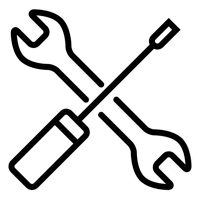AEMC 6472 Multifunction Digital Ground Resistance Tester Kit - 300ft
SKU code: 2135.53
The AEMC model 6472 multifunction digital ground resistance tester is available in complete kit form, which includes the instrument, two 300 ft color-coded leads on spools (red and blue), two 100 ft color-coded leads (green and black), four 14.5" T-shaped auxiliary ground electrodes, one set of five spaded lugs, 100 ft tape measure and carrying bag.
Features:
- 4-Pole (4-Point) Fall-of-Potential measurement for very low resistance measurements with manual or automatic frequency selection and automatic lead compensation
- 3-Point Fall-of-Potential measurement
- 3-Point earth coupling measurement
- Manual or automatic frequency scan from 40 to 513Hz for test accuracy in electrically noisy environments
- Earth coupling testing
- Selectable test voltage 16 or 32V up to 250mA test current
- 4-Point soil resistivity measurement with automatic calculation of Rho and user selection of Wenner or Schlumberger test method
- 2- and 4-Wire DC resistance measurement (Bond testing) with automatic polarity reversal
- Ground Resistance with 2 clamps (no auxiliary rods)
- Ground Resistance of Pylons with the GroundFlex™ Adapter Model 6474 and GroundFlex™ sensors allow the system to measure leakage current and ground resistance of tower legs without disconnecting the overhead ground conductor.
- Includes DataView® software for data storage, real-time display, analysis, report generation and system configuration
- Auto-off power management
- Automatic recognition of all electrode connections and their resistance value
- Stores up to 512 complete test results in internal memory
- Optically isolated USB communication
- Rechargeable NiMH batteries from wall charger or vehicle power
- Rugged dustproof and rainproof field
Applications:
- 3-Point measurements of resistance to ground of ground rods and grids. 3-Point measurements are used when electrode or grid can be easily disconnected.
- 4-Point tests or soil resistivity measurements. Locating areas of lowest soil resistivity is essential for achieving an economical grounding installation.
- Touch and step potential testing measurements. These tests are recommended when the ground cannot be disconnected, where ground faults are highly likely to occur, or when the “footprint” of grounded equipment (the outline of the part of equipment in contact with earth) is comparable to the size of the ground to be tested.
- 2- or 4-Wire tests for continuity tests on bonding or on grounding systems. Test is a DC resistive test using 250mA or more and is used to check bonding of all connection points on the ground system.
Earth coupling measurement and display. Used to estimate the influence of two earth resistance systems that are not connected to each other.
More From This Category














